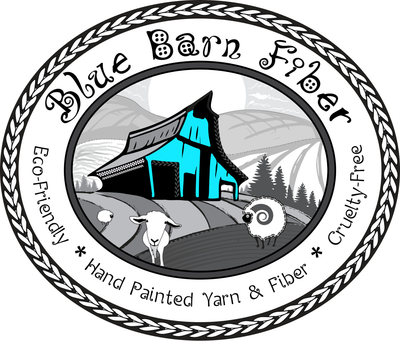Superwash Wool: How it’s made, environmental tradeoffs, and why responsibly-made wool often still beats acrylic
In terms of sustainability, nothing beats untreated (non-superwash) wool. Unfortunately, untreated wool can be difficult to dye, and even more difficult to care for. It must be hand washed in cold water, laid flat to dry, and handed with extreme care. It's prone to felting, takes significantly more water to dye and rinse, and doesn't take color as vibrantly as treated wool. It has microscopic barbs on it that interlock when rubbed together, which is what causes the shrinkage that wool is notorious for. For some people (I'm one of them), those microscopic barbs also cause skin irritation, which can lead many people to incorrectly believe they are allergic to wool. It's just not practical for most people to use untreated wool, so textile scientists created an alternative option, called "superwash" wool. This is the only type of wool that I dye, and even though it's not as sustainable a untreated wool, it's still a fantastic option that's better for the earth than synthetic fibers, like acrylic yarn.
This page explains the common industrial and research methods used to make wool “superwash” (machine-washable, non-felting) and weighs the environmental pros and cons of each. It also addresses a frequent claim — that superwash wool is “just plastic” — and shows why, when you examine supply chains and treatment methods, wool frequently retains lifecycle advantages over acrylic and many other synthetic alternatives. This page does a deep dive into the scientific processes used, so you can skip all of that and just read the summary if you don't want to go into too much detail.
Why wool felts — and what “superwash” must change
Wool fibers have overlapping surface cuticle scales. Heat, moisture and mechanical agitation make those scales interlock — that’s felting and shrinkage. Superwash methods either (A) blunt or remove those scales, or (B) coat the fiber with a smooth film so the scales can’t catch. High-magnification SEM images are the clearest way to show this.

Main superwash methods — how they work, pros & cons
A. Chlorine oxidation + polymer resin (classic “Chlorine–Hercosett”)
How it works: Controlled oxidation with chlorine (hypochlorite or gaseous chlorine) partially etches or loosens cuticle scales; a cationic polyamide-epichlorohydrin resin such as Hercosett 125 is applied and fixed to form a smooth protective film on the fiber. This combination produces exceptionally durable machine-washability.
Pros: Highly effective, inexpensive at industrial scale, durable through many washes.
Cons: Chlorination can produce AOX (adsorbable organic halogens) in effluent; epichlorohydrin chemistry and the final PAE resin are petrochemical and largely non-biodegradable. AOX formation and regulatory wastewater limits are the primary environmental concerns for this route.
B. Chlorine variants & AOX-reduction engineering
Some mills use improved chlorine reactors, scrubbing and effluent treatment to reduce uncontrolled AOX. These reduce risk but do not remove the fundamental dependence on chlorine chemistry and resin finishes.
C. AOX-free oxidative methods (ozone, peroxide) + alternative binders
Using ozone or hydrogen peroxide instead of chlorine can avoid AOX formation; pairing these oxidants with non-halogenated binders yields AOX-free superwash processes in pilot and industrial trials. Performance often approaches the classic route when the binder is optimized.
D. Enzyme (protease) based anti-felting finishing
Proteases selectively digest or soften the cuticle layer, reducing felting tendency. Enzymes are biodegradable and lower-toxicity chemistry; modern enzyme protocols are improving durability and reducing fiber damage when carefully controlled. However, enzymes alone often require additional fixation or mild binders for long-term durability.
E. Plasma / low-pressure & atmospheric plasma surface modification
Plasma treatments physically oxidize and modify the fiber surface (removing lipids, creating hydrophilic groups, changing topology). Plasma can act as an AOX-free pre-treatment and deliver durable anti-felting when combined with appropriate binders. The EU LIFE SUPERWOOL project developed plasma-based approaches explicitly to replace chlorine/Hercosett.
F. Alternative polymer coatings (silicones, polyacrylates, graft polymers)
Mills sometimes use silicone emulsions or acrylic/methacrylate-based films instead of PAE resins; these can avoid halogen chemistry but are still synthetic polymers (raising biodegradability and microplastic concerns).
Environmental evidence: key facts to weigh
- AOX risk from chlorine + resin is well documented. This is the single most-cited environmental issue with the classic process — regulatory limits and wastewater controls focus on AOX measurement.
- Hercosett-type resins are polyamide-epichlorohydrin (PAE) polymers. They form a crosslinked, cationic film; epichlorohydrin is reactive and its use and residues are regulated for health/safety reasons.
- Acrylic (polyacrylonitrile) is fossil-derived and not biodegradable. Acrylic fiber manufacture is petrochemical- and energy-intensive; acrylic garments are a known source of synthetic microfibers when laundered.
- Enzyme and plasma routes materially reduce hazardous chemistry. Enzyme and plasma pre-treatment options remove AOX formation risk and are increasingly shown to produce durable anti-felting when combined with non-halogenated binders.
- There is no single universal LCA that settles wool vs acrylic for every scenario. Lifecycle results are highly sensitive to boundaries (cradle-to-gate vs cradle-to-grave), local energy mix, wastewater treatment, and product lifetime. Because wool is renewable and often longer-lasting, it frequently performs better — but uncontrolled chlorine effluent can make some impact categories worse.

Why responsibly-finished superwash wool is still better than acrylic:
- Renewable & biodegradable base material: Wool is a natural, renewable fiber that biodegrades in appropriate conditions — acrylic does not. This is a foundational material advantage.
- Longer usable life: Wool garments often last longer (thermal performance, pilling/wear characteristics), and a longer lifetime reduces environmental footprint per use. LCAs that include lifetime frequently favor wool.
- Microfiber context: . Acrylic is a well-documented source of synthetic microfibers. Polymer coatings on wool could theoretically release fragments if they degrade, but the data on resin-film shedding are limited; acrylic’s laundering microfiber problem is a proven impact.
-
We can eventually eliminate the worst chemical problems: AOX risk from chlorine can be removed by selecting AOX-free processes (plasma, enzyme, ozone + non-halogenated binders) as they become more readily available, or by sourcing mills with strict effluent controls. When those are used, wool keeps its material advantage and avoids the main chemical downside.
Superwash Wool FAQ
What does “superwash” mean?
Superwash wool is natural wool that’s been treated so it can be safely machine washed without shrinking or felting. The process smooths the outer scales of the fiber, making it soft, durable, and easy to care for.
Is superwash wool still real wool?
Absolutely. Superwash treatment doesn’t change the fiber’s core — it’s still 100% natural wool, with all the warmth, breathability, and moisture-wicking properties you expect. The treatment simply prevents felting in the wash.
How is superwash wool treated?
There are several methods. The most common is the chlorine–Hercosett process, which gently removes the fiber’s outer scales and coats them with a thin polymer for protection. Newer AOX-free methods use enzymes, ozone, or plasma to achieve similar results with fewer chemicals.
Is the chlorine process bad for the environment?
Traditional superwash systems that use chlorine can create AOX (adsorbable organic halides) if not properly managed — but most modern mills now capture and neutralize these byproducts before they enter wastewater. Many producers are also switching to AOX-free or plasma-based treatments that avoid chlorine altogether.
How does superwash wool compare to acrylic yarn?
Acrylic yarn is 100% synthetic plastic made from fossil fuels and sheds non-biodegradable microplastics with every wash. Superwash wool, by contrast, is a renewable, biodegradable natural fiber — even with its polymer coating, it breaks down far faster and has a much smaller environmental footprint.
Is superwash wool biodegradable?
Yes. Studies show that superwash-treated wool still biodegrades in soil and water — the natural protein core breaks down completely. The thin polymer coating may take longer, but overall decomposition is much faster and cleaner than any synthetic fiber.
What are AOX-free or enzyme-based superwash methods?
AOX-free systems use oxidative enzymes, ozone gas, or low-pressure plasma to modify the wool’s surface without chlorine. These processes greatly reduce chemical waste and make wool finishing safer for the environment while keeping the fiber machine-washable.
What’s the best choice for eco-conscious knitters?
If you want low maintenance and real sustainability, superwash wool from a responsible mill is an excellent choice. It’s natural, renewable, biodegradable, and made with increasingly cleaner technology — far better for the planet than acrylic or conventional cotton. We care about the environment and only source our yarn from ethical and conscientious mills, so you can rest easy whenever you buy your yarn from us.
Sources:
- Hassan MM & Carr CM, “A review of the sustainable methods in imparting shrink resistance to wool fabrics”, Journal of Advanced Research (2019).
- EU LIFE project “Sustainable AOX-free Superwash Finishing of Wool Tops” (LIFE05-ENV-D-000195) — SUPERWOOL project page.
- EP patent & polymer descriptions for polyamide-epichlorohydrin resins (Hercosett 125) — patent document.
- Recent AOX-free plasma & enzyme studies (peer-reviewed, 2023–2025) demonstrating durable AOX-free finishes.
- LCA and industrial assessments for acrylic production and comparisons with natural fibers; acrylic’s microfiber issues.



